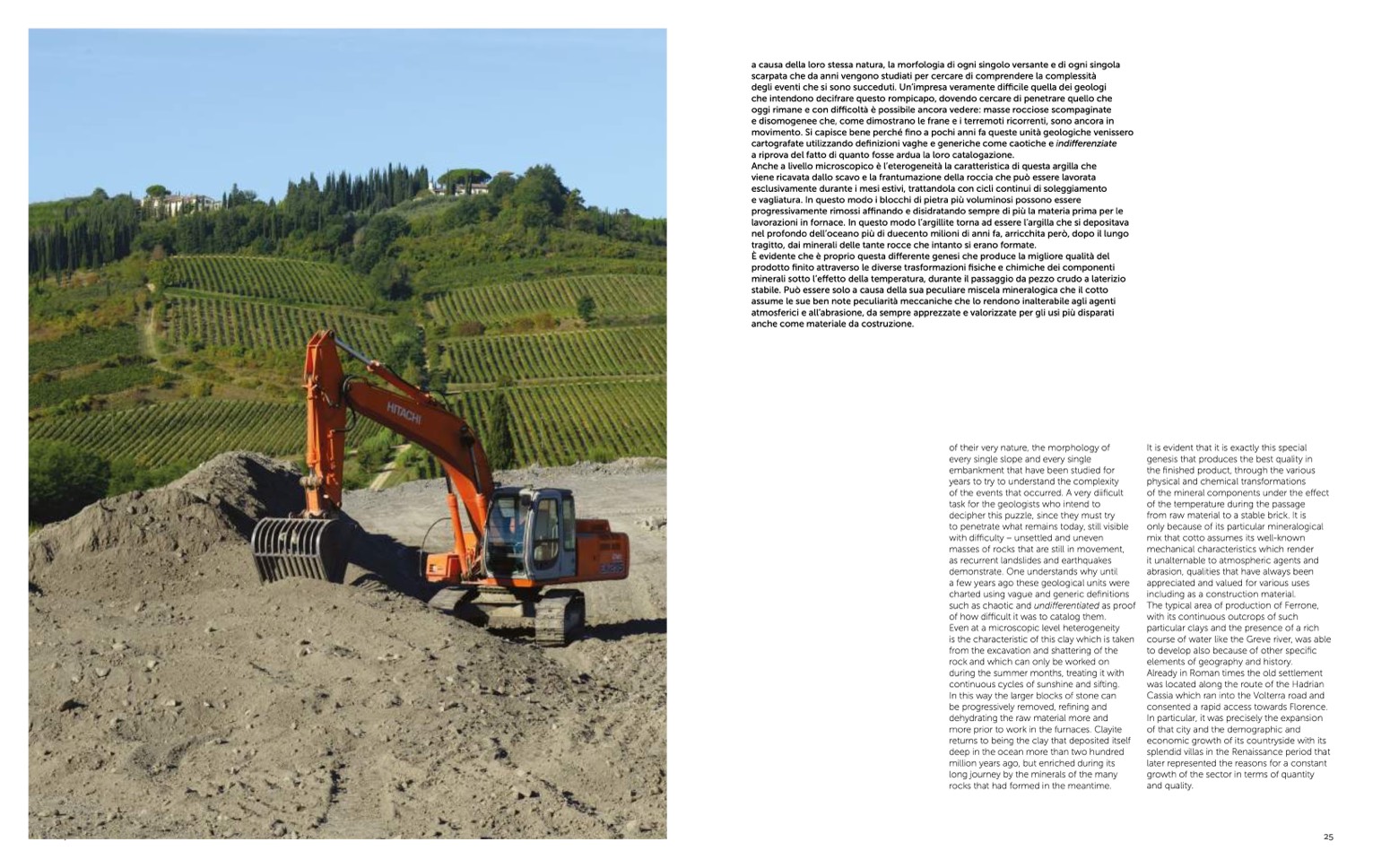
24
25
a causa della loro stessa natura, la morfologia di ogni singolo versante e di ogni singola
scarpata che da anni vengono studiati per cercare di comprendere la complessità
degli eventi che si sono succeduti. Un’impresa veramente difficile quella dei geologi
che intendono decifrare questo rompicapo, dovendo cercare di penetrare quello che
oggi rimane e con difficoltà è possibile ancora vedere: masse rocciose scompaginate
e disomogenee che, come dimostrano le frane e i terremoti ricorrenti, sono ancora in
movimento. Si capisce bene perché fino a pochi anni fa queste unità geologiche venissero
cartografate utilizzando definizioni vaghe e generiche come caotiche e indifferenziate
a riprova del fatto di quanto fosse ardua la loro catalogazione.
Anche a livello microscopico è l’eterogeneità la caratteristica di questa argilla che
viene ricavata dallo scavo e la frantumazione della roccia che può essere lavorata
esclusivamente durante i mesi estivi, trattandola con cicli continui di soleggiamento
e vagliatura. In questo modo i blocchi di pietra più voluminosi possono essere
progressivamente rimossi affinando e disidratando sempre di più la materia prima per le
lavorazioni in fornace. In questo modo l’argillite torna ad essere l’argilla che si depositava
nel profondo dell’oceano più di duecento milioni di anni fa, arricchita però, dopo il lungo
tragitto, dai minerali delle tante rocce che intanto si erano formate.
È evidente che è proprio questa differente genesi che produce la migliore qualità del
prodotto finito attraverso le diverse trasformazioni fisiche e chimiche dei componenti
minerali sotto l’effetto della temperatura, durante il passaggio da pezzo crudo a laterizio
stabile. Può essere solo a causa della sua peculiare miscela mineralogica che il cotto
assume le sue ben note peculiarità meccaniche che lo rendono inalterabile agli agenti
atmosferici e all’abrasione, da sempre apprezzate e valorizzate per gli usi più disparati
anche come materiale da costruzione.
of their very nature, the morphology of
every single slope and every single
embankment that have been studied for
years to try to understand the complexity
of the events that occurred. A very diificult
task for the geologists who intend to
decipher this puzzle, since they must try
to penetrate what remains today, still visible
with difficulty – unsettled and uneven
masses of rocks that are still in movement,
as recurrent landslides and earthquakes
demonstrate. One understands why until
a few years ago these geological units were
charted using vague and generic definitions
such as chaotic and undifferentiated as proof
of how difficult it was to catalog them.
Even at a microscopic level heterogeneity
is the characteristic of this clay which is taken
from the excavation and shattering of the
rock and which can only be worked on
during the summer months, treating it with
continuous cycles of sunshine and sifting.
In this way the larger blocks of stone can
be progressively removed, refining and
dehydrating the raw material more and
more prior to work in the furnaces. Clayite
returns to being the clay that deposited itself
deep in the ocean more than two hundred
million years ago, but enriched during its
long journey by the minerals of the many
rocks that had formed in the meantime.
It is evident that it is exactly this special
genesis that produces the best quality in
the finished product, through the various
physical and chemical transformations
of the mineral components under the effect
of the temperature during the passage
from raw material to a stable brick. It is
only because of its particular mineralogical
mix that cotto assumes its well-known
mechanical characteristics which render
it unalternable to atmospheric agents and
abrasion, qualities that have always been
appreciated and valued for various uses
including as a construction material.
The typical area of production of Ferrone,
with its continuous outcrops of such
particular clays and the presence of a rich
course of water like the Greve river, was able
to develop also because of other specific
elements of geography and history.
Already in Roman times the old settlement
was located along the route of the Hadrian
Cassia which ran into the Volterra road and
consented a rapid access towards Florence.
In particular, it was precisely the expansion
of that city and the demographic and
economic growth of its countryside with its
splendid villas in the Renaissance period that
later represented the reasons for a constant
growth of the sector in terms of quantity
and quality.

